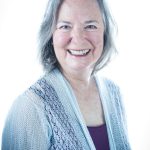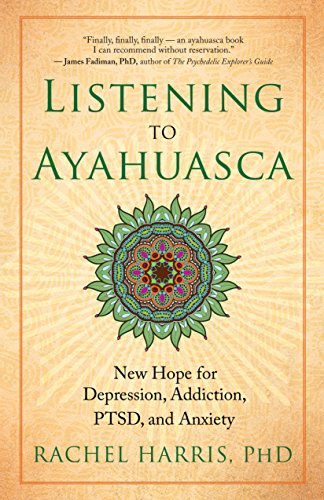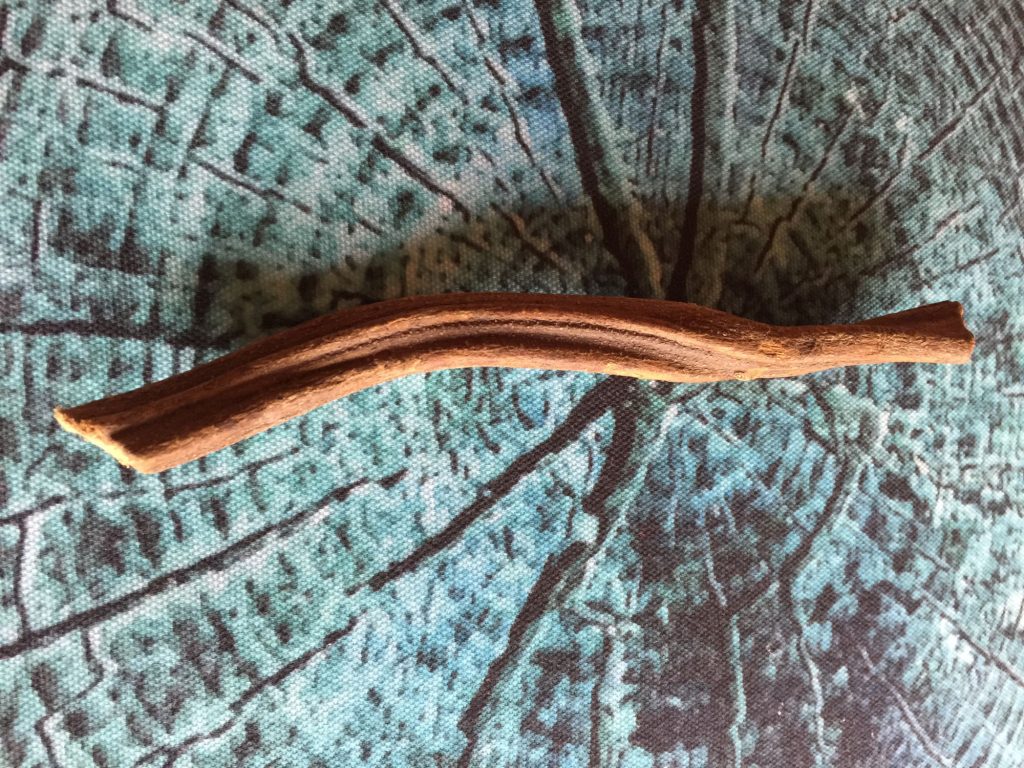It is with pleasure that we welcome our AoM for September, Rachel Harris PhD, and her study on the benefits of integrating ayahuasca into Western psychotherapeutic practice.
Rachel’s methods bring Western-scientific objectivity and Eastern-scientific subjectivity together to form an at once visionary and pragmatic approach to lasting healing.
“At once accessible and well informed, this work represents a much-needed guidepost for health professionals who may encounter ayahuasca users in their practice, as well as for spiritual seekers with an interest in entheogens.”
— Albert Garcia-Romeu, PhD, Behavioral Pharmacology Research Unit, Johns Hopkins University School of Medicine
I’ve been Listening to Ayahuasca for more than a decade now. I’ve journeyed into the mystical darkness of the cosmos and suffered and cried in ceremony after ceremony. I’ve struggled and failed to live up to her advice and I’ve had my heart space scrubbed clean and polished. And I accepted on full faith her mission to research how the medicine is being used in the Western set and setting of North America.
As a cautious researcher and an enthusiastic psychotherapist, I’ve talked with hundreds of people about their ayahuasca ceremonies, sometimes taking research notes, other times encouraging therapeutic insight, and always asking: “What happened next? How did you change? How is your life different?”
This book is not a simple story about healing. The risks associated with ayahuasca ceremonies are significant, but the therapeutic opportunity is beyond what Western medicine and psychotherapy can offer.
Listening to Ayahuasca is intended for people considering ayahuasca, and for people drinking the medicine. I hope it will help them integrate their insights and visions into their daily lives. There is much work people can do on their own to maximise the healing that ayahuasca offers. I also hope this book will inform psychotherapists about the process of integration after ayahuasca ceremonies, so they can provide a supportive and respectful container for the unfolding of healing.
The phrase tossed around the ayahuasca underground is that “one ceremony is more helpful than ten years of psychotherapy.” That is quite a claim, and I wanted to hear first-person accounts explaining how the medicine had made a difference in people’s lives well beyond the ceremony. The underlying questions were, “What was the meaning of your experience? How has it changed your life?”
The same questions arose decades ago regarding the long-term spiritual impact of psychedelic drugs. That is, one mystical experience does not make a mystic, the distinction being between a religious experience and a religious life. As psychiatrist Roger Walsh explained, “The universal challenge is to transform peak experiences into plateau experiences, epiphanies into personality, states into stages, and altered states into altered traits.”1Professor of Religion, Huston Smith, described the same issue more poetically: “to transform epiphanies into abiding light.”2
My best description of the impact of ayahuasca is that it’s a rocket boost to psychospiritual growth and unfolding. This kind of transformation is called “quantum change”3 in the professional literature, which acknowledges that psychology knows very little about it. Philosopher William James explained such dramatic change with his theory of “discontinuous transformation,” meaning that the psychological and spiritual leap is not a gradual evolution marked by education or practice but, rather, is a sudden, inexplicable awakening.4 In the case of ayahuasca testimonies, the leap is not inexplicable but directly attributable to the medicine, or to the spirit of the medicine. Perhaps both the chemical impact of the brew and the esoteric power of Grandmother Ayahuasca are involved. Mystery prevails.
Integration
Everyone talks about integrating these kinds of experiences, but few do anything about it. Psychologist Scott Hill noted this disconnect, writing, “Consider the ubiquitous references in the psychedelic literature to the importance of integrating psychedelic experiences on the one hand, and the striking lack of discussion of what is meant by integrating psychedelic experiences on the other.”5
We need more details about what the process of integration actually looks like. Psychologist and psychedelic elder Ralph Metzner cautioned that “experiences only really become part of our ongoing growth and learning when recorded or told in some way.”6
When working with someone after an ayahuasca ceremony, I tend to emphasize creative expression for integration. I want the person’s awareness to move back and forth between the memory of the expanded state of consciousness to consensus reality. I encourage whatever creative modality the client prefers, from expressive movement, art, and music to poetry, in order to move the experience through levels of awareness and expression.
I follow the Gestalt therapy approach to dreams, in that I don’t interpret the description of what happened during the ayahuasca ceremony. I also don’t interpret the person’s creative expression. I especially resist concrete or simplistic interpretations like, “This color means…” or “That’s a symbol of…;” I hold the visionary experience to be sacrosanct. However, the person’s reflections on the experience, how he or she feels and thinks about what happened, is open for interpretation and exploration from different perspectives.
British psychiatrist Ron Sandison said his process of integration involved an alternating movement from the inner realms of visionary experience to the outer world and then back again.7 There’s an intentional flow of awareness back and forth between states of consciousness to refine the story, detail the experience, and explore meaning for oneself and one’s community. It’s this process of travelling between psychic states that allows the unconscious material to enter into the full light of consciousness. This process may take weeks or even months, manifesting in nighttime dreams, artistic expression, or changes in behaviour.
Ayahuasca ceremonies open us up to unconscious material — an extraordinarily wide range of psychological issues, insights, perinatal or past-life memories, and archetypal images can arise from the unconscious.8 If these are not worked through within a therapeutic context, they slowly sink back down, possibly to be acted out unconsciously in destructive ways.
Coming to a multilayered understanding of ayahuasca experiences involves discernment, the process of differentiating a spiritual message from that of the ego.9 The word discernment comes from a Latin word meaning “to sift apart.” We have to recognise the self-serving nature of our ego or of the parts of our personality that tell us what we want to hear. Be especially wary of those who say, “Grandmother Ayahuasca (or Spirit) told me to ….”
We must also be willing to acknowledge when we avoid psychological issues via a spiritual by-pass. John Welwood coined this term to describe premature transcendence,10 which is basically a defence mechanism against dealing with unresolved emotional issues or wounds by shifting levels from personal history to archetypal realms.
Core Issue
The core issue for most of us is that we yearn to be loved and accepted for who we are. Ideally, this need should have been fulfilled during our earliest years in a secure relationship with our parents, but that’s often not the case, and so we search for feeling loved in romantic relationships. However, finding unconditional love in adult relationships is rare, and when bad behaviour is involved, it’s downright unrealistic.
The same core issue surfaces in psychedelic therapy with added intensity amid psychological regression. In ayahuasca ceremonies, people sometimes view visionary home movies of their childhood while maintaining an outside observer’s perspective. At other times, they relive a childhood event as if it were happening in the ceremonial moment — they regress in age to the time of the scene. Either way, ceremonies often open up deep feelings of wanting to be accepted and loved.
Grandmother Ayahuasca seems to have both sentience and intention in her therapeutic recalibration of a person’s energy field and psyche. She seems to know, like a heat-seeking missile, how to target the core issue. Anthropologist Richard Doyle described his experience of Grandmother Ayahuasca: “This feeling of plant agency was inseparable from the healing….In short, a sense of being instructed was crucial to my healing.”11 It’s possible that a relationship with Grandmother Ayahuasca is the critical therapeutic factor, despite what this might mean for our Western worldview.
The corrective experience that can happen with ayahuasca is very similar to what psychotherapist Ann Shulgin described in MDMA-assisted therapy sessions. As pure MDMA helps to reduce the fear and loathing of the shadow parts of the person’s personality, “there arises a peaceful acceptance of whatever is encountered, and an unaccustomed compassion for himself, an acceptance of all the aspects of his own nature, giving and selfish, kind and vengeful, loving and despicable.”12
Shulgin described this experience as “being held in the loving hands of God, one of the most healing experiences any human being can have.” The therapeutic value of this “experience of unconditional self-acceptance” and “absolute validation” spontaneously leads to the falling away of old, defensive habits.
In Shulgin’s description, this experience goes beyond the reparenting that other psychedelic therapists have advocated. It’s spontaneous and can’t be initiated or even facilitated by the therapist; it’s no longer just a psychologically corrective experience but an ecstatic encounter with the Divine.
Spiritual Experience
Discerning a psychological experience from a numinous or spiritual one is a critical skill for a therapist working in psychedelic realms. If someone has been age-regressed and physically nurtured during a psychedelic session, the therapist can feel free to explore this experience over many therapy sessions in a process of psychological integration. It takes time and many rounds of asking self-reflective questions: How did that feel? Could you let that feeling sink deeply into your body so you can feel it in your bones? Now that you know what it feels like to be so well-loved, how do you view your mother and father? How were your parents nurtured by their parents? How has the need for loving acceptance played out in your adult relationships? How do you think your need is different now? How will this difference in you make a difference in your current relationships?
However, if the psychedelic experience was “being held in the loving hands of God,” the therapist should only say, “Wow.” No exploration, no verbal integration. At most, the advice might be to “hold that experience in your heart.” The person might want to do a drawing with oil pastels, write in their journal in prose or poetry, listen to music, walk in the garden, or dance in the woods. A compelling urge for creative expression often arises out of the depths. On the other hand, any traditional, verbal therapeutic approach to such a numinous experience, even with the best of intentions, could dilute or corrupt it or, even worse, diminish or undermine the experience.
How does the therapist know how to discern a psychological experience from a numinous one? The only way is for the therapist to be personally familiar with these interior territories. A naïve therapist might misinterpret the spiritual experience, downgrading it to something psychological with which he or she is more familiar and more comfortable. No one who’s experienced this level of numinous love wants to be told it was a fantasy or wish fulfillment.
Also, the person should not tell and retell his or her experience of cosmic love, turning it into just another self-aggrandizing story. My advice “to hold the experience in your heart” is literal. A person should keep it internal, only externalizing it in creative expression. The experience will continue to work on the person from the inside in its own time and way. In the case of Grandmother Ayahuasca, the experience of feeling loved by her will both deepen and expand. Trust this process, nourish it with attention, notice subtle changes, and cultivate gratitude for the unfolding process.
What sometimes follows is a gradual rearrangement of inner architecture with a new benchmark for feeling loved. The old self-schema — “I’m unlovable or not good enough to be loved” — might morph into “I’m lovable and deserve to be loved.” People who feel in their heart of hearts that they deserve to be loved will make different decisions in both friendships and romantic relationships. They’ll have a different standard for how they want to be treated by themselves and others. There will be less likelihood of continuing to act out a repetitive compulsion — choosing a partner similar to one of their parents who will trigger childhood issues of neglect, rejection, or abandonment. In other words, a person will be reprogrammed, and this transformation should be observable in neurological changes in the architecture of the brain.13
Endnotes
1. Roger Walsh, “Entheogens: True or False,” International Journal of Transpersonal Studies 22 (2003): 4.
2. Huston Smith, The Illustrated World’s Religions: A Guide to Our Wisdom Traditions (New York: HarperSanFrancisco, 1991), 248.
3. Janet C’de Baca and Paula Wilbourne, “Quantum Change: Ten Years Later,” Journal of Clinical Psychology 60, no. 5 (May 2004): 532, http://thirdworld.nl /quantum-change-ten-years-later.
4. William R. Miller, “The Phenomenon of Quantum Change,” Journal of Clinical Psychology 60, no. 5 (May 2004): 454.
5. Scott J. Hill, Confrontation with the Unconscious: Jungian Depth Psychology and Psychedelic Experience (London: Muswell Hill Press, 2013), 129.
6. Ralph Metzner, Allies for Awakening: Guidelines for Productive and Safe Experiences with Entheogens (Berkeley, CA: Regent Press, 2015), 165.
7. Ronald Sandison, “The Role of Psychotropic Drugs in Individual Therapy,” Bulletin of the World Health Organization 21, nos. 4–5 (1954): 499, http://www.ncbi.nlm.nih.gov/pmc/articles/PMC2537985/pdf/bullwho00504-0105.pdf.
8. Stanislav Grof, “Revision and Re-enchantment of Psychology: Legacy of Half a Century of Consciousness Research,” Journal of Transpersonal Psychology 44, no. 2 (2012): 146, http://atpweb.org/jtparchive/trps-44-12-02-137.pdf.
9. Llewellyn Vaughn-Lee, Prayer of the Heart in Christian and Sufi Mysticism (California: The Golden Sufi Center, 2012), 8.
10. John Welwood, Towards a Psychology of Awakening, Buddhism, Psychotherapy and the Path of Spiritual Transformation (Boston: Shambhala Publications, 2000),
11. Richard Doyle, “Healing with Plant Intelligence: A Report from Ayahuasca,” Anthropology of Consciousness 23, no. 1 (spring 2012): 39.
12. Ann Shulgin, “The New Psychotherapy: MDMA and the Shadow,” in Psychoactive Sacramentals: Essays on Entheogens and Religion, ed. Thomas B. Roberts (San Francisco: Council on Spiritual Practices, 2001), 200.
13. Hasse Karisson, “How Psychotherapy Changes the Brain,” Psychiatric Times, August 11, 2011, http://www.psychiatrictimes.com/psychotherapy/how-psychotherapy-changes-brain.
Rachel Harris, PhD. is the author of Listening to Ayahuasca. She was in the 1968 Esalen Residential Program, worked in research for a decade and in private psychotherapy practice for thirty-five years. She received a National Institutes of Health New Investigator’s Award and published more than forty scientific studies in peer-reviewed journals. She lives on an island off the coast of Maine and in the SF Bay area. www.listeningtoayahuasca.com










It sounds such a helpful experience. Thank you for your insight and if ever I try ayuasca, I would like you, or someone like you, to be around after it.
I think I would find Ayahuasca very helpful. Do you, or any readers, know of any trials or studies in the UK?
I’m extremely pleased to discover this great site. I need to to thank you for
ones time for this particularly fantastic read!!
I definitely liked every part of it and i also have you book-marked to check out new information in your website.
Hi my family member! I want to say that this post is amazing, great written and include approximately all important infos.
I would like to see extra posts like this .
What i don’t realize is in truth how you are now not really a lot
more neatly-appreciated than you might be now.
You are very intelligent. You know therefore considerably with regards to this matter,
made me in my view imagine it from numerous various angles.
Its like men and women aren’t involved unless it’s something to accomplish with Lady gaga!
Your individual stuffs outstanding. All the time care for it up!
Heya i’m for the first time here. I found this board and I to find It truly helpful & it helped me out a
lot. I’m hoping to provide something back and help others like you
aided me.